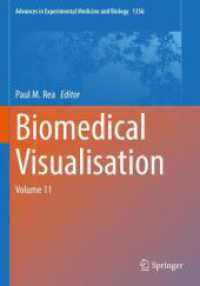- ホーム
- > 洋書
- > 英文書
- > Science / Mathematics
Full Description
Microgravity profoundly impacts terrestrial biological systems, altering cellular functions, metabolic processes,
and physiological responses. This book explores the diverse effects of microgravity on cellular and molecular
biology, immune function, cancer research, and microbiome dynamics. We examine changes in cell morphology, gene expression, protein synthesis, and metabolic pathways, shedding light on how gravitational forces
shape biological processes. The implications extend beyond space exploration, offering insights into regenerative medicine, biotechnology, and disease modeling. By leveraging microgravity research, we can develop
innovative therapeutic strategies and biomanufacturing techniques for both space-based and Earth-bound
applications. As humanity prepares long-duration missions, understanding these biological adaptations is
critical for advancing space medicine and ensuring astronaut health, while simultaneously unlocking new
frontiers in biomedical research.
Maybe we will be able to synthesize self-replicating molecules capable of self-replication, catalysis,
and evolution within an appropriate environment. We haven't been able to do so on Earth, perhaps
due to the constraints of gravity?
Making amazing stuff in space is gravy, just have to take "it" out...
Contents
Chapter1 Effects of Microgravity on Terrestrial Biological Systems Chapter 2 Cellular and Molecular Effects of Microgravity Chapter 3 Gene Expression and Protein Synthesis in Microgravity Chapter 4 Microgravity and Cell Growth, Proliferation, and Differentiation Chapter 5 Stem Cell Behavior and Differentiation in Microgravity Chapter 6 Effects of Microgravity on Cellular Metabolism and Biochemistry Chapter 7 Lipid and Protein Metabolism in Microgravity Chapter 8 Effects on Protein Degradation Pathways Chapter 9 Consequences of Proteasomal Dysregulation Chapter 10 Changes in Ion Transport and Homeostasis in Microgravity Chapter 11 Effects on Intracellular pH and Membrane Potential Chapter 12 Immune System and Microgravity Chapter 13 Inflammatory Response and Cytokine Production in Microgravity Chapter 14 Implications for Astronaut Health and Performance Chapter 15 Cancer and Microgravity: The Effects on Cancer Cell Behavior Chapter 16 Gene Expression Changes in Oncogenic Pathways Chapter 17 Microgravity as a Model for Cancer Research Chapter 18 Drug Resistance and Therapeutic Targeting in Microgravity Conditions Chapter 19 Effects on Microorganisms and the Microbiome: Bacterial and Fungal Growth in Microgravity Chapter 20 Human Microbiome Alterations in Microgravity Chapter 21 Biomanufacturing in Space Chapter 22 Using Microgravity Research for Improving Disease Models Chapter 23 Translating Findings to Improve Regenerative Therapies and Drug Development Chapter 24 Next Bowl of Gravy References Index








